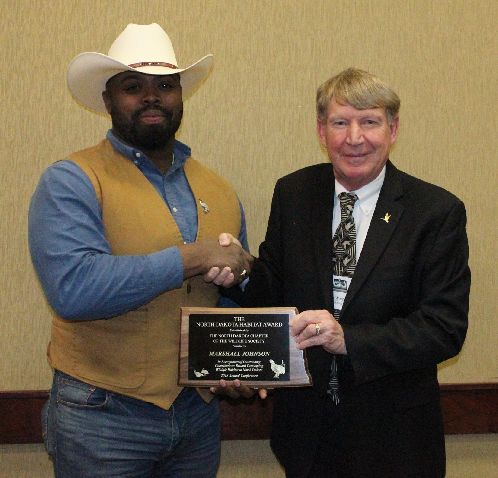News & Events
February 19, 2018
Marshall Johnson receives ND Habitat Award

During the awards banquet, Chapter President Rick Warhurst highlighted Marshall's efforts and brought him to the stage with the following:
The North Dakota Habitat Award
The North Dakota Habitat Award is presented to an individual, or group that has made an outstanding contribution toward preserving, improving and/or establishing high-quality wildlife habitat on the lands of North Dakota. We will present a North Dakota Wildlife Habitat Award tonight.
This year’s Habitat Award recipient certainly has made outstanding contributions to improve wildlife habitat in North Dakota. He was born in California, raised in Texas and attended college in Minnesota. His genuine belief is that conservation and landowner needs are congruent and that actions can be taken that are mutually beneficial – a perspective that has served him well in establishing relationships to make a marked difference in the Dakotas’ landscape. As an avid sportsman, this individual is dedicated to creating and strengthening relationships with landowners that offer opportunities for improvement in wildlife habitat and agriculture production. Beyond the notable achievements that he pursues for his organization, he finds time to collaborate with other groups to broaden the scope of success for all. He has served on the North Dakota Natural Resources Trust Board of Directors for five years, including two years as President of the Board. He is currently Vice President of the Trust’s Board of Directors. He provides an invaluable partnership and insight to make us all better land stewards and resource-conscious.
For seven years he has been Executive Director of Audubon Dakota and during this time has led the organization in a number of program successes in the Dakotas. Highlights of these include:
● Creation of the Urban Woods and Prairies Initiative. Marshall brought together multiple landowning entities along the Red River in 2014 including the Fargo Park District, City of Fargo, City of Moorhead and the Buffalo-Red River Watershed District. Though it started small with just one site in Fargo, with Marshall’s relationship building skills and ability to motivate thriving partnerships, Audubon Dakota now helps the landowning entities along the River manage nearly 1,000 acres of restored prairie and woodlands.
● Development of Audubon’s Conservation Ranching Program. This program collaborates with local ranchers within the North American Grasslands, ensuring that grazing regimes produce healthy habitats for target grassland bird species while creating a new market for cattle producers. Audubon facilitates the marketing of certified Bird Friendly Beef in both Dakotas. Marshall was an early advocate for the program and influenced how the program was formed. In the Dakotas, Marshall built many strong relationships with grass-fed livestock producers that have now enrolled over 62,000 acres in the Audubon Conservation Ranching Program. This Conservation Ranching Program exemplifies how Marshall can create, engage and fulfill made promises.
● Management of North Dakota Audubon Sanctuaries.
Audubon currently manages two sanctuaries totaling 3,000 acres in North Dakota by implementing grazing systems and fire management to improve the health of the grasslands. Through Marshall’s leadership, Audubon has successfully received NRCS EQIP contracts and a North Dakota Outdoor Heritage Fund grant to fund implementation of grazing projects and adaptive land management.
● Promotion of the Grand Forks County Prairie Management Toolbox.
Marshall conceptualized the Grand Forks County Prairie Management Toolbox which provides private and public landowners the support needed to qualify for government programs that offer assistance for conservation-focused agriculture practices. This Toolbox has resulted in the implementation of managed grazing systems on over 1,500 acres with emphasis on lands enrolled in expired CRP and/or the Game and Fish Department’s PLOTS program. The Toolbox has led to improved habitat diversity on approximately 10,000 acres through the removal of invasive woody vegetation. The emphasis has again been directed to expired CRP and PLOTS lands. The Toolbox has provided financial and field resources for prairie restoration on 200 acres.
● Establishment of the Wolsey Important Bird Area Habitat Conservation Project in South Dakota.
Several years ago Marshall identified Wolsey IBA as a critical area for wetland and grassland conservation. He made it a goal for Audubon to apply for a NAWCA Standard Grant to perform conservation in this project area in central SD (Hand, Hyde, Faulk, and western Beadle and Spink Counties). Marshall led the effort to gain project partners such as DU, USFWS, SDDGF&P, SD Grassland Coalition and James River Watershed Development District. In 2017 Audubon Dakota fulfilled the goal and the project was approved by the NAWCA Council and the Migratory Bird Conservation Commission to receive $1,00,000 to perpetually protect 1,300 acres of important wetland and grassland habitat as a staging area for Sandhill cranes but also as production habitat for waterfowl, wading birds, shorebirds, marsh birds and grassland passerine bird species.
One of Marshall’s co-workers at Audubon Dakota states, “Marshall has revolutionized how Audubon Dakota operates and influences conservation within the Dakotas. His commitment to the Dakota grasslands, landowners, partners and grassland-dependent wildlife species is an inspiration, especially for those of us who get to work with him on a daily basis. Marshall’s conservation passion is contagious. Not only does he place enormous emphasis on protecting and restoring the Dakota landscape, he also recognizes the great importance of building and sustaining quality relationships with fellow conservation groups and private landowners. This is how long-lasting, positive environmental impacts are created and defended”.
Please help me recognize and congratulate my good friend Marshall Johnson as this year’s Habitat Award recipient from the North Dakota Chapter of the Wildlife Society.
Photo credit to Collin Riley.
